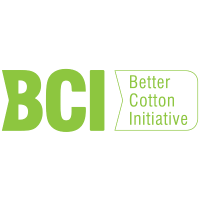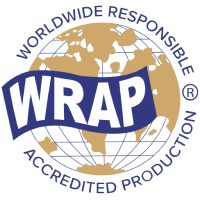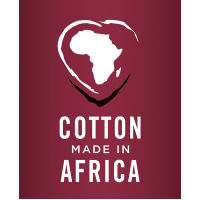What Type of Cotton Fabric is the Most Sustainable?

With sustainable fashion becoming mainstream (which we love), consumers are taking a deeper look into the types of materials they’re purchasing and the ethics of the companies they're purchasing from.
Cotton is often regarded as a sustainable material since it’s a plant-based, natural fabric. However, the sustainability of cotton is more complex than many realize. There are three main types of cotton, conventional cotton, organic cotton, and recycled cotton, and their sustainability greatly varies between the three.
Read further to discover these differences and learn which type of cotton is the most sustainable.
What Makes a Product “Sustainable”?
Before diving into the types of cotton, it’s important that we have a strong grasp on what the word sustainable actually means. If you’ve done any research into environmentally friendly practices, you’ve heard the word “sustainable” thrown around a lot.
However, this is more than just a buzz word that companies use in their marketing efforts. Creating and distributing sustainable products is one of the best things a company can do for the environment and society.
So, what does it really mean? The actual word sustainable simply means “able to be maintained at a certain rate over time”. When it comes to business practices, it translates to creating products that do not require non-renewable resources, minimize the negative impact on the environment, and are not detrimental to individuals or society as a whole.
Let’s break those down a little further.
Do Not Require Nonrenewable Resources
Nonrenewable resources are natural resources that cannot be naturally replaced faster than they are consumed. The main non-renewable resources are coal, oil, natural gas, and nuclear energy, commonly referred to as “fossil fuels”.
Fossil fuels are not only extremely damaging to the environment, causing oil spills, air pollution and more, but they will also run out eventually, leaving us to find new sources of energy.
Minimize Negative Impact on the Environment
Everything we do affects the environment in some way. So, companies that offer sustainable products aim to minimize their negative impact on the environment as much as possible.
This can include using less energy, using recycled materials, responsibly disposing of waste, and using local resources to reduce transportation emissions.
Are Not Detrimental to Individuals or Society as a Whole
Many people are actually unaware that sustainability goes further than protecting the environment. A truly sustainable company will use ethical practices to protect its employees and positively impact all consumers. Socially sustainability includes fair hiring practices, diversity representation, inclusive sizing, and safe & fair working conditions.
There are many more widely used eco words out there that you might as well need to clarify for yourself. Our glossary of eco terminology will help you understand the differences and be able to see the greenwashing through.
The Importance of Sustainable Fashion
We often think about the environmental and social impact of energy sources, factories, large corporations, and things like that. However, we forget that something as simple as the clothes we wear has a huge impact on the environment, as well. The fashion industry, specifically fast fashion, profoundly contributes to so many serious issues like resource depletion, climate change, food insecurity, human rights issues, water pollution, and habitat destruction.
By opting for a sustainable fashion choice, consumers are doing their part to save natural resources, reduce their carbon footprint, conserve water, and support safe and fair working conditions.
Cotton Sustainability Standards & Certifications
A great way to prove that a cotton product is sustainable is by identifying its cotton certifications. These accreditations serve as approval from a third-party organization that the business and product meet their standards for sustainability. Some of these include Better Cotton Initiative, WRAP, and Global Organic Textile Standard.
Better Cotton Initiative

The Better Cotton Initiative promotes sustainable ways of growing cotton to farmers. Its standards include reduction of harmful crop protection practices, efficient use of water, care for the health of the soil, natural habitat conservation, preservation of the quality of the fiber, and decent work practices.
According to The World Wildlife Foundation, “Farmers that adopt these best management practices are growing healthier cotton, with less pesticide, fertilizer and water overruns”.
Find out more about Better Cotton Initiative
Worldwide Responsible Accredited Production (WRAP)

WRAP is a certification for socially responsible textile factories. It promotes safe, lawful, and ethical manufacturing practices.
It is known for its twelve principles that include, “following laws and workplace regulations, no forced labor, no child labor, prohibition of harassment or abuse, compensation and benefits, fair hours of work, no discrimination, health and safety, freedom of choice to join workers associations, compliance with environmental rules, follow customs laws, and ensuring security”.
Global Organic Textile Standard (GOTS)

GOTS has both environmental and social standards that a textile company needs to comply with to become certified. Their goal is to build a truly sustainable textile industry, so their standards cover the processing, manufacturing, packaging, labeling, trading, and distribution of organic textiles.
Products can either be certified as “organic” meaning they’re made with at least 95% organic fibers, or “made with organic materials” requiring only 70%.
Cotton Made in Africa

Cotton made in Africa is one of the world’s leading standards for sustainably produced cotton. CmiA bases its work on three sustainability pillars: people, planet and prosperity with the main goal being to help people help themselves via trade rather than donations.
On average, to produce one kilogram of cotton there is used 1,563 liters of water. Cotton produced under CmiA standards requires just 2 liters.
Find out more about Cotton made in Africa
Conventional Cotton
Conventional cotton is the most common form of cotton growth around the world. It is grown with the use of agrichemicals like fertilizers, herbicides, and insecticides. The use of these pesticides is not only negatively impacting the environment, but pests are becoming immune to them, creating the need for even stronger, more harmful substances.
Conventional cotton is typically grown monoculturally from genetically modified seeds, meaning it’s the only crop grown in a large area over many seasons. This strategy of farming is popular with large, industrialized farmers as it reduces overall costs, but can be very detrimental to the crop itself, land, and environment. The lack of diversity within a monocultural farm presents serious threats of pests, unhealthy soil, and overuse of harmful pesticides.
Additionally, conventional cotton farms are known to significantly deplete surface and groundwater sources and pollute clean water with pesticides and fertilizers. According to a European Parliament 2021 study, between the growth and production of cotton products, it takes about 2,700 liters of water to produce one cotton T-shirt, which is approximately the same amount of drinking water that one person consumes in 2.5 years.
Organic Cotton
Organic cotton is cotton that is grown without pesticides or genetic modification. Farmers avoid using harmful chemicals when growing organic crops and place environmental sustainability at the forefront of their practices. Organic cotton uses fewer resources and the land on which the cotton is grown typically has a longer lifespan, since it’s not riddled with harmful chemicals.
Instead of pesticides and fertilizers, organic farmers use natural methods to maintain healthy crops and deter pests. These include crop rotation, cover crops, trap crops, and resistant crops. All of these methods utilize the benefits of having a diverse ecosystem to naturally grow healthy crops.
Biodiversity and organic growing methods also reduce the amount of water usage. According to The Textile Exchange’s organic cotton market report in 2021,
“Well-managed organic systems with better nutrient-retentive abilities greatly reduce the risk of groundwater pollution. The higher amounts of soil organic matter in these systems result in a ‘sponginess’ in the soils, which reduce pressure on water resources by holding onto more water than conventionally managed soil”.
Most organic cotton is rainfed, instead of irrigated, which reduces the use and pollution of local water sources.
While organic cotton does solve a lot of the issues that growing conventional cotton creates, it is still not a perfect practice. Organic cotton often requires more land to produce, as it can yield fewer fibers than genetically modified cotton.
Additionally, when shopping for cotton products it’s important to keep in mind that just because it was grown organically does not mean that the processing, manufacturing, and distribution practices are sustainable.
To ensure that you’re buying a truly sustainable product, look for the GOTS certification that we discussed earlier. Plenty of brands use the word organic as a shady marketing tool to make consumers think their product is sustainable when it isn’t.
Recycled Cotton
Recycled cotton is made from previously used cotton fabric. This fabric is converted into fibers that can be reused in new ways. Recycling cotton keeps cotton away from landfills and, if produced enough, could reduce the need for new cotton production in the future.
According to a study conducted by the US Environmental Protection Agency, “Landfills received 11.3 million tons of MSW (municipal solid waste) textiles in 2018. This was 7.7 percent of all MSW landfilled”. With cotton being one of the top loved fabrics, the fraction of it that ended up rotting on a field is huge.
Recycled cotton comes from a variety of sources including excess material from cotton production, used garments, used upholstery, towels, and household items. Items are separated by type and color, then shredded into small fibers by a machine. These fibers are typically respun into yarn and sold to companies that create recycled cotton products.
The biggest downfall to recycled cotton is that this shredding process significantly compromises the quality of the new fibers. The recycled cotton is often too weak or short to be made into new products on its own. Because of this, other materials such as plastic or new cotton are often blended with recycled cotton to make it stronger and easier to use.
Which Cotton Fabric is Most Sustainable?
Conventional Cotton vs. Organic Cotton
When it comes to cotton farming, organic cotton is significantly more sustainable than conventional cotton. Conventionally grown cotton uses harmful chemicals in the form of pesticides and fertilizers, irrigation systems that deplete and pollute local water sources, and genetically modified seeds.
Organic farming also saves energy. According to the Textile Exchange, “by avoiding the use (and manufacturing) of synthetic inputs. Organic practices can reduce energy consumption by up to 30-70 percent per unit of land”.
The lack of pesticides used in organic farming not only protects the crops and soil, but the people working on and around the cotton farm as well. Earth Justice found that, in the US, there are approximately 10,000 to 20,000 acute pesticide poisonings of agricultural workers annually. Side effects of pesticide exposure include eye irritation, rashes, blisters, headaches, and respiratory issues in the short-term, and an increased risk of chronic health conditions in the long-term.
Organic farming is, overall, a much more sustainable method of growing cotton, and organizations like the Better Cotton Initiative and GOTS ensure that organic cotton farming and production is held to the highest standards for environmental and social impact.
Organic Cotton vs. Recycled Cotton
When simply looking at the actual process itself of growing or recycling cotton, recycled cotton wins the “most sustainable” award hands down. However, it isn’t quite as simple as we all hoped it would be.
Recycled cotton is a wonderful innovation and saves tons of cotton from ending up in landfills, which is always a good thing. However, since the recycling process of shredding the cotton into new fibers damages the material so much, it can’t be recycled continuously. Also, the virgin materials that recycled cotton are blended with to make it stronger are not always sustainable themselves.
Another point that should be touched on is that recycled cotton production is currently quite low, making the price of recycled cotton products out of many consumers’ budgets.
As we discovered, organic cotton is a far superior alternative to conventional cotton as far as sustainability, but it also comes with faults. As it still uses a significant amount of water, land, and resources.
So, the moral of the story is that while both of these methods are much more sustainable than conventional cotton, there’s still progress needed. Luckily, cotton production is constantly being innovated and improved upon, and we believe that more sustainable alternatives are on the horizon.
FAQ’s
Is Cotton Biodegradable?
Yes, cotton, like any plant-based product, is biodegradable. It will typically biodegrade quickly since it is made of cellulose.
Is Cotton a Renewable Resource?
Yes, cotton is a renewable resource. Farmers are able to replant and grow cotton crops annually.
What are the Sources of Recycled Cotton?
Recycled cotton is sourced from either pre-consumer or post-consumer material. Pre-consumer material includes excess fabric, scraps, and by-products from cotton manufacturing. Post-consumer materials are goods that have already been bought and used. These can include clothing, towels, linens, and upholstery.
Is GOTS Better than Oeko Tex?
While any organic certification is a good certification, GOTS is widely considered the highest standard in the world.
Final Thoughts
If you can find certified organic or recycled cotton, it is always a more sustainable choice than conventional cotton.
Conventional cotton farming and production pose a lot of risks on the environment. While not perfect, organic and recycled cotton work hard to reduce their negative environmental and social impact as much as possible, making them the far more sustainable option.